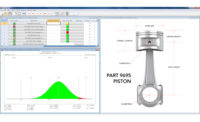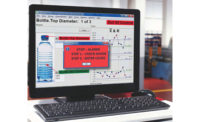Getting the right answer sometimes means asking the right questions, and determining appropriate calibration software is no exception to this pattern.
Managing complex calibration records and setting up a gage management system can be overwhelming tasks, to be sure. Turning the job over to the IT department in an organization is not the single answer, and yet technology plays a critical role in the task. So how does one determine which direction to go when making a decision about gage management software? Of course, the most important consideration is establishing the need, and whether a given solution will meet the specific needs of your organization. In addition, a number of questions should be asked, in order to determine specific needs and to assess the demands that will be placed on the software. The needs of the organization for accurate calibration records must be provided, but unless the right people are involved in the decision, the wrong software can generate costs and employee frustration. So the approach to the decision may be a simple one: Begin by asking these 10 questions, and then ask more questions.
Tech Tips
|
1. What kind of help is available?
Any software program, regardless of how easy it is to install and use, has features and tools that may not seem apparent at first exposure. A robust help system offered by the developer will not only respond to specific questions or challenges, but will also offer tips to make the best use of the program’s features. First, determine whether the software provides online help files and user guides, and look at these carefully to assess their usefulness and user-friendliness. A good software company offers technical support that goes beyond a “Press 1…,” “Press 2…” recorded approach to your questions. What is the company’s reputation for technical support and analysis? Will the analyst understand your industry demands or be able to respond to company-specific needs? And here’s an important one: Will a real-live person answer my call? Genuine help often entails a give-and-take conversation that cannot be replicated by a robotic or electronic tech support analyst.
2. What is the cost of support?
Increasingly, software providers are offering for-fee technical service. Find out what this fee is, whether there is a limit on the number of support contacts you can have, and whether a long-term maintenance agreement is available. Hidden costs for per-call help can add up over the long run, and can provide a disincentive to asking for help in the first place. Ideally, technical support is provided at no per-call charge, through up-front maintenance agreements that identify the exact cost and assure the ability to pick up the phone as needed.
3. How frequently is the software revised and upgraded?
You might ask whether a maintenance agreement guarantees automatic upgrading when a revision takes place, or if you will be charged a per-revision upgrade fee. You may also want to see a timeline that indicates how frequently upgrades and revisions are actually produced. If your software will not be revised for several years, its long-term usefulness may be questionable.
4. Is there an opportunity for input from users about potential features or requirements?
A software developer that relies only on internal input will miss the mark by blocking the voice of the customer in its decisions about new releases. Does the company provide opportunities for specific customer requests, and if so, how does it pursue this process? Is the software provider reactive, responding to specific requests, or does it stay on top with approaches to discover the ways that users are actually deploying the software to unleash innovation?
5. Is the software easy to use?
Easy to use means that the software will actually be used to bring about improvement—not simply become shelfware, rather than the useful tool that it may offer. Sometimes developers are so eager to add features that they forget that customers will find the program too complex and difficult to navigate. Everyone has had the experience of downloading a program and then feeling so daunted by the challenge of installing and using it that the process of putting it to work is delayed or even abandoned. Examine recent upgrades to the product and determine whether developers have the end-user in mind when it comes to ease of use. How friendly is the user interface for this product?
6. What about training?
Ongoing training can be available in a variety of formats, from on-site instruction to public seminars and webinars. Check to see what follow-up training is available for the product and its upgrades. Consider the cost of training as well, not just for one-time sessions, but in ongoing support of learning and help for those who join the organization later. A software company’s website will be a good indicator of its commitment to training, with a calendar of dates for webinar or seminar instruction and a process for registration easily accessible.
7. What kinds of reports are available to assist managers in making decisions about the gage management system?
Gage management is a complex task, with a variety of approaches. Determine whether the software includes useful reports and output to analyze the system itself. As you consider which solution will be the best for your organization, be sure to check with those who will use or benefit from the program to discover what kinds of reports they may want or need. Leaving out a critical report may doom the software when it comes to using its potential savings and efficiency.
8. Does the software meet your organization’s audit requirements?
If compliance to ISO 9001: 2015, TS16949, ISO 10012, ISO/IEC 17025, 21CFR11.1, and other standards is important, it is essential that the software is up to date with respect to these certifications. Determine how the developer addresses issues related to audit trails and acceptance. Your need for such trails may be critical to the certification to standards that you require; if the software does not provide this evidence, it may not serve your needs.
9. What deployment options are available?
Is the program scalable throughout the organization, including distant sites and additional facilities that may be acquired, as well as across the supply chain? To utilize a variety of programs in a multi-site organization, rather than a single choice, undermines the possibility for collaboration and continued learning. When employees move to alternate facilities, they will be prepared to use the software immediately if it is uniform across sites and through the supply chain.
10. Who is the provider of the software?
In an age when brand loyalty may be diminished in the interest of simply saving costs, it is important to know that the software developer has been providing high quality products to customers for years, rather than weeks or months. It is essential to be able to rely on the support of the developer through the life of the product and through multiple upgrades and releases of the product. This is no time to consider a fly-by-night developer for your software.
Since individual organizations may have specific requirements when it comes to management of gages and calibration equipment, it is critical to know which software programs will best address these requirements. Asking the right questions may mean the difference between long-term success with gage management software or disappointment in its failure to serve expected needs.
And the first right question may very well be, “What questions need to be answered before making this purchase?” Q



